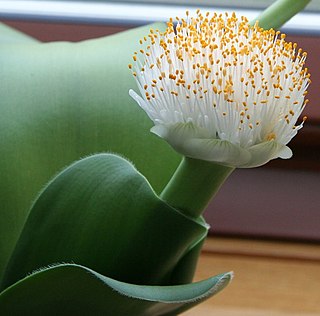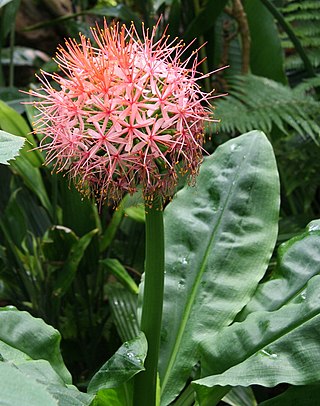
Haemanthus is a Southern African genus of flowering plants in the family Amaryllidaceae, subfamily Amaryllidoideae. Members of the genus are known as blood lily and paintbrush lily. There are some 22 known species, native to South Africa, Botswana, Namibia, Lesotho and Eswatini. About 15 species occur in the winter rainfall region of Namaqualand and the Western Cape, the remainder being found in the summer rainfall region, with one species Haemanthus albiflos occurring in both regions.

Haemanthus amarylloides Jacq. is an endemic South African bulbous plant. It was first described in 1804 by Nikolaus Joseph von Jacquin from specimens sent to the Schönbrunn Palace gardens by the collectors Boos and Scholl. Franz Boos was an Austrian botanist who, with Franz Bredemeyer, made up Emperor Joseph II's gardening team. Boos and his assistant Georg Scholl, were collecting Cape plants for the imperial gardens. These collections were transported to Vienna by Nicolas Thomas Baudin, who had been carefully briefed by Boos on the techniques used for keeping plants and animals alive on long ship voyages.

Haemanthus coccineus, the blood flower, blood lily or paintbrush lily, is a species of flowering plant in the amaryllis family Amaryllidaceae, native to Southern Africa. Growing to 35 cm (14 in) tall and wide, it is a bulbous perennial with short brown stems surmounted by red flowers, the flowers appearing in spring and summer, before the strap-shaped leaves.

Scadoxus puniceus, commonly known as the paintbrush lily, is a species of bulbous plant. It is native to much of southern and eastern Africa: Ethiopia, Sudan, Tanzania, Malawi, Mozambique, Zambia, Zimbabwe, Botswana, Eswatini (Swaziland), and South Africa. Scadoxus puniceus can be found in cool, shady habitat such as ravines and forests, where it is often found in moist leaf litter. Other common names include snake lily, royal paintbrush, King-of-Candida, African blood lily (English), rooikwas (Afrikaans), isisphompho, and umgola (Zulu). There are nine species of Scadoxus of which three, S. puniceus, S. multiflorus and S.membranaceus, occur in South Africa.

Kumara haemanthifolia is a species of flowering plant in the family Asphodelaceae. It is a rare species of succulent plant, native to a few high, inaccessible mountain peaks in the Fynbos habitat of Western Cape, South Africa.

Scadoxus multiflorus is a species of bulbous plant native to most of sub-Saharan Africa from Senegal to Somalia to South Africa. It is also native to Arabian Peninsula and to the Seychelles. It is naturalized in Mexico and in the Chagos Archipelago.It is also found in Indian peninsula. It is grown as an ornamental plant for its brilliantly coloured flowers, either in containers or in the ground in where the climate is suitable. There are three recognized subspecies. Strongly toxic like other Scadoxus species, it has been used as a component of arrow poisons and fishing poisons, as well as in traditional medicine. Common names, some of which are used for other species, include blood lily, ball lily, fireball lily, blood flower, Katherine-wheel, oxtongue lily, poison root and powderpuff lily.

Scadoxus cinnabarinus is a herbaceous plant from tropical rainforest in Africa. It is native to Western and Central Africa from Sierra Leone in the far west to Angola in the south. It has been reported from Ghana, Côte d'Ivoire, Nigeria, Niger, Sierra Leone, Central African Republic, Cameroon, Congo, Equatorial Guinea, Gabon, São Tomé, Zaire, Uganda, and Angola.
The South African National Biodiversity Institute (SANBI) is an organisation tasked with research and dissemination of information on biodiversity, and legally mandated to contribute to the management of the country's biodiversity resources.

Haemanthinae is a small subtribe of Haemantheae, and therefore within the African clades of Amaryllidoideae. It consists of two genera, Haemanthus, and Scadoxus.

Dierdré "Dee" Anne Snijman is a South African botanist and plant taxonomist who is notable for studying and writing extensively on bulbs. She has described over 120 species and has written comprehensive works on South African flora. She received the 1997 Herbert Medal from the International Bulb Society for her research on Amaryllis.
The Kwelera Nature Reserve is a coastal dune forest reserve in the Wild Coast region of the Eastern Cape, South Africa. Access to the reserve is through the adjacent Kwelera National Botanical Garden, where the reserve now serves as the natural portion of the garden. The reserve stretches from the Kwelera River on the eastern side, to the Gqunube River (Gonubie) at the western end of the reserve. It is a park in the greater East London Coast Nature Reserve.

Haemanthus deformis is a perennial flowering plant and geophyte belonging to the genus Haemanthus. The species is endemic to the Eastern Cape and KwaZulu-Natal and occur from Umtata to Durban. The plant only grows in the forests near the coast and is threatened by the traditional medicine industry.

Haemanthus humilis is a perennial flowering plant and geophyte belonging to the genus Haemanthus. The species is native to South Africa, it occurs in every province, as well as Botswana and Lesotho.

Haemanthus lanceifolius is a perennial flowering plant and geophyte belonging to the genus Haemanthus.

Haemanthus montanus is a perennial flowering plant and geophyte belonging to the genus Haemanthus. The species are native to Gauteng, KwaZulu-Natal, Mpumalanga, North West, Eastern Cape and the Free State as well as Botswana.
Haemanthus namaquensis is a perennial flowering plant and geophyte that belongs to the genus Haemanthus and is part of the Succulent Karoo vegetation. The species is native to the Northern Cape and Namibia. It occurs from southern Namibia to Karkams in Namaqualand. There are eight subpopulations in an area of occurrence of 4000 km2, the plant is considered rare.

Haemanthus nortieri is a perennial flowering plant and geophyte belonging to the genus Haemanthus. The species are endemic to the Western Cape and occur on the Nardouwberg. The plant has an area of occurrence smaller than 100 km² and there are three subpopulations. It is threatened by overgrazing and trampling by livestock, road construction, invasive plants and illegal collection by horticulturists.

Haemanthus pumilio is a perennial flowering plant and geophyte that belongs to the genus Haemanthus and is part of the fynbos and Renosterveld. The species are endemic to the Western Cape and occur at Stellenbosch. The plant has lost 60% of its habitat in the last 90 years with at least 20% occurring in the last 60 years due to crop cultivation and development. There are currently two subpopulations left consisting of approximately 2000 plants. These plants are threatened by illegal collection by horticulturists, uncontrolled fires and destruction by locusts and rodents.
Haemanthus tristis is a perennial flowering plant and geophyte belonging to the genus Haemanthus. The species is endemic to the Northern Cape and the Western Cape and occurs in the southeastern Tankwa Karoo, where there are five subpopulations.














